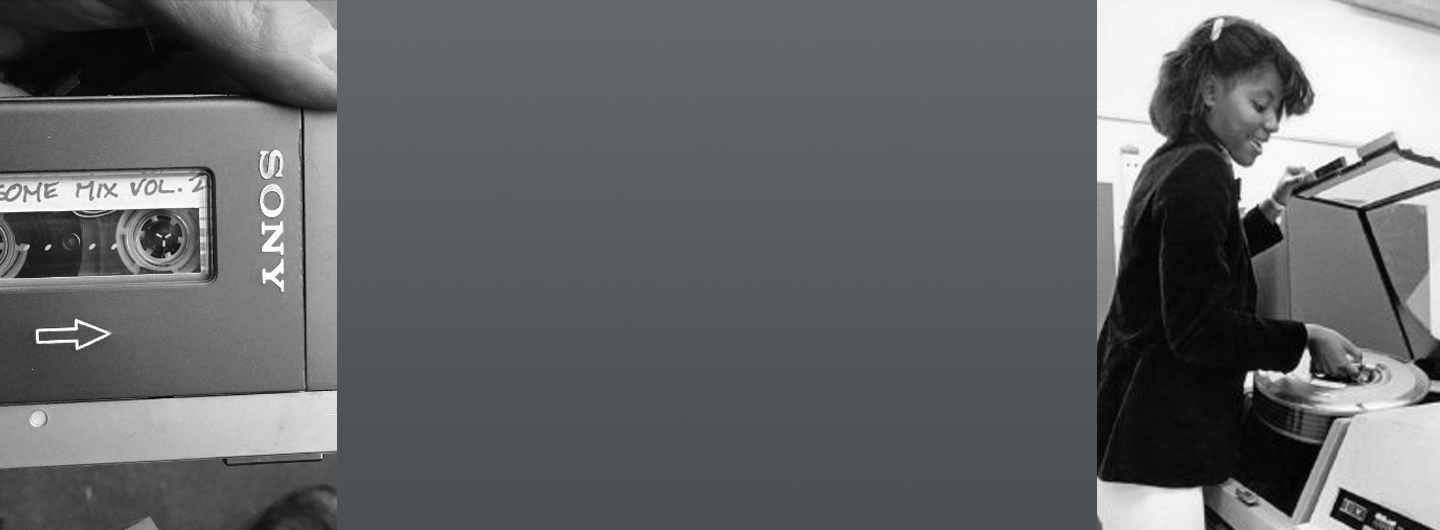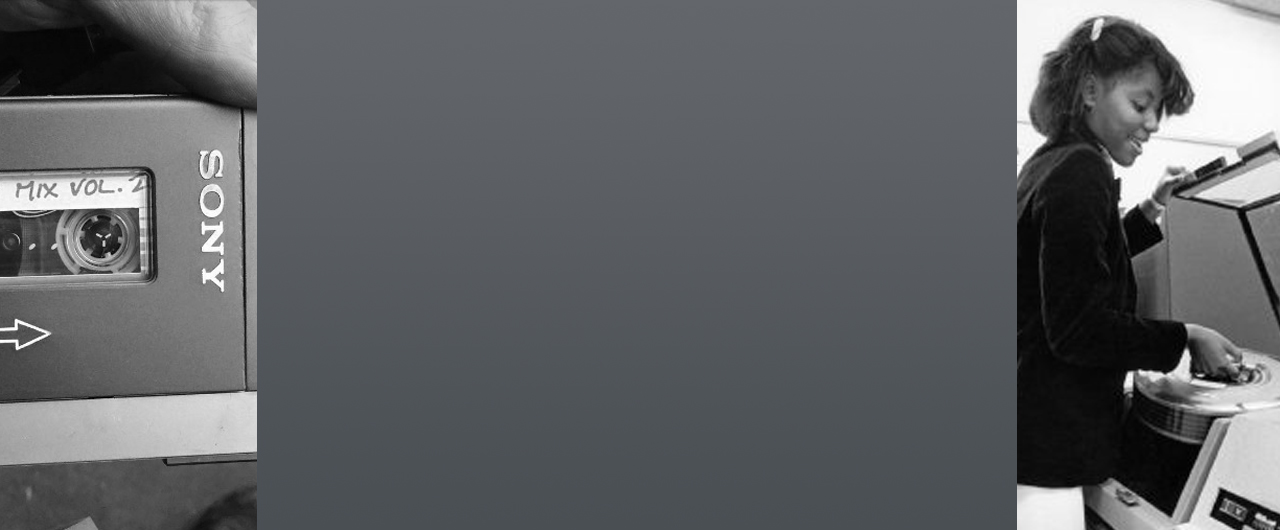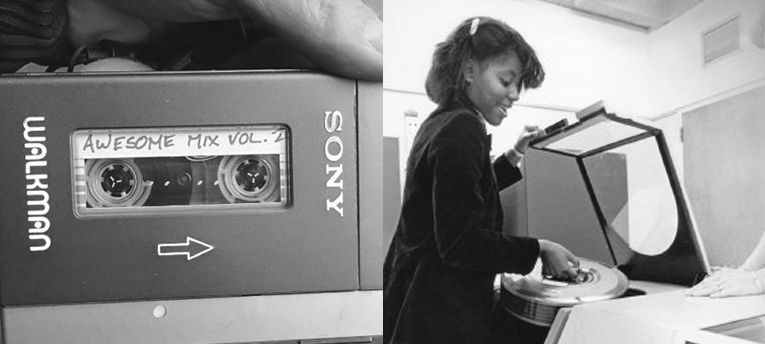





Magnetization, the alignment of magnetic dipoles in iron and other ferromagnetic metals, has been used to store information since the invention of the wire recorder in 1898 by Valdemar Poulsen. The invention of the telephone twenty-two years earlier had demonstrated that sound could be converted to a varying electric current and back again. Poulsen realized that such a current could also drive an electromagnet to record the signal as variations in the magnetization of a moving steel wire. Those variations were an analog of the original sound wave.
Since then, magnetization has been used to store everything from sound to video to data in both analog and digital form. It can be applied to any geometry that can be moved past the recording head, including tape, disks, cards, belts and sheets. It can be written and read quickly enough to handle large amounts of information in real time. It can be erased and reused. Finally, over time, its storage density has increased by many orders of magnitude. As a result, much of the data stored in the cloud lives on magnetic disks, and magnetic tape is still used for archival backup.















































































































































































A wire recorder records sound by magnetizing a thin steel or stainless steel wire as it moves past an electromagnet. Although invented in 1898, adoption was limited until after World War II, when wire recording had a short heyday before being overtaken by magnetic tape.
Wire recorders were used in business for dictation and as answering machines and in the home to record radio shows and family performances. Ruggedized versions were heavily used by the military in World War II. Recording wire, only slightly larger than the diameter of a human hair, held a relatively large amount of audio in a small volume, which made it useful for clandestine recording by intelligence agencies and the police. Wire was also used in flight recording, where the heat tolerance of steel gave it advantages over tape. A wire recorder was used in the 1958 SCORE satellite to broadcast President Eisenhower's voice back to earth, the first spoken words ever received from orbit: "Through the marvels of scientific advance, my voice is coming to you from a satellite circling in outer space."
Recording wire was typically stored on an open metal or plastic spool, which could hold an hour or more of audio.
Loading wire into a recorder was a finicky process; the wire was difficult to manipulate and easily broken or tangled. Once tangled the only practical solution was to cut out the tangle and tie the ends together with a knot. As a result, wire was the first audio medium to be packaged as a cassette.


In his initial patents for wire recording, Poulsen also included metal tape and paper tape coated with iron filings, but he never produced a device that used either. In 1930, the BBC put into service a device called the Blattnerphone that recorded onto steel tape (moving at 5 ft per second—somewhat dangerous if the tape broke). But magnetic tape in the sense that we now think of it wasn't actually produced until 1928 in Germany. During the 1930s, companies like AEG and BASF worked on it, largely in secret. After the war, Frank Mullin, a major in the U.S. Army Signal Corps, discovered the technology in Germany and brought it back to the U.S. He demonstrated a tape recorder to Bing Crosby, among others. Crosby, who was looking for a way to prerecord his radio show, quickly adopted and backed the technology. The first consumer tape recorder was introduced in 1946 by Brush Development Corp. using paper-backed tape. Ampex introduced the Model 200 professional recorder in 1948 using ¼ in. acetate tape developed by 3M.
Magnetic tape fundamentally altered the process of recording music. Before tape, all recording was essentially live. Performances were recorded directly onto cylinder and disc records, which provided limited opportunity for editing. Tape introduced the possibility of post-production. It could be edited like movie film by cutting and splicing. In widths up to 2 inches, tape allowed the recording of as many as 24 independent tracks, which allowed individual voices and instruments to be recorded separately and mixed later. In the 1960s, albums like The Beatles' Sgt. Pepper's Lonely Hearts Club Band and The Beach Boys' Pet Sounds showed that the studio engineer could be a participant in the performance ultimately delivered on vinyl.
As with wire recording, the first tape recorders used open reels. Prerecorded reels were introduced as early as 1949, but saw their greatest use in the 1960s. In those days, a reel-to-reel tape deck in the den signified a connoisseur who appreciated and could afford high-end audio. For consumers, open reel tape was soon replaced by cartridges and cassettes, but it remained the primary media for professional recording into the late 1980s.
Like recording wire, tape on open reels could break or tangle. Numerous ways of packaging tape were invented in response. A single reel could be stored in a shell, to be threaded manually or automatically, with the machine grabbing the end of the tape when it was inserted, attaching it to an internal takeup reel, then rewinding it into the shell when it reached the end.
The need to rewind open-reel tape made it impractical for repetitive applications like point-of-sale, background music or radio broadcasting. The difficulty of threading tape also made open reels less than ideal for portable and in-car use. These problems were first addressed in continuous tape cartridges, which contain an endless loop of magnetic tape wound around a single reel. Tape is pulled from the inside of the reel (making lubrication a key technical challenge) and is wound back onto the outside of the reel.
Bernard Cousino invented the first such cartridge, the Audio Vender, a special reel designed to play on a standard tape recorder for point-of-sale audio. Soon after, George Eash developed the Fidelipac cartridge, which went on to become the standard format for radio broadcasting. Earl "Madman" Muntz, a southern-California auto dealer famous for the persona he adopted in his TV advertisements, developed a 4-track cartridge based on the Fidelipac for use in the cars he sold. Bill Lear, developer of the Learjet, thought Muntz's cartridge would be as useful for jets as it was for cars. In the process of adapting it, he made a number of changes that culminated in the 8-track cartridge. Although not particularly high-quality, "8-tracks" went on to become a cultural icon. An 8-track tape player was the centerpiece of many a shag-carpeted van in the late 60s and early 70s.
A tape cassette holds two reels side-by-side in a hard shell. The tape is fixed to both reels and can be inserted into the player without hand threading. There were a number of early cassette formats—often targeted at dictation—before Philips developed the familiar compact cassette in 1962. In contrast to many inventors of new media formats, Philips licensed it at no cost to other manufacturers and it was widely adopted. Prerecorded cassettes followed in 1965 and came to dominate the market for recorded music, surpassing vinyl in the mid-1980s (only to be eclipsed by the compact disc in the 1990s). The sound quality wasn't as good as vinyl or reel-to-reel tape, but a cassette was easy to use in a car, could be played in a portable player and could survive storage in a shoebox. The cassette format was later adopted for digital audio, as well as analog and digital video.
Cassettes came to occupy an important place in popular culture. They let people bring their music with them: in their car—it was a cassette that played Bohemian Rhapsody in the film Wayne's World—or walking around (not to mention roller-blading, as in a famous ad for the Sony Walkman). Cassettes made the boom-box possible. With cassettes, the concept of a "mix-tape" became a fixture in popular culture, a concept that lived on with writable CDs and as playlists for streaming media.
A coaxial-reel cartridge is similar to a cassette, but with the two reels stacked on a single spindle. The tape moves diagonally from the top to the bottom reel.
A strip is a finite length of magnetic tape not connected to itself to form a loop. It has a beginning and an end like the tape in a cassette, but the ends aren't wrapped around reels. It's a little hard to picture and the Mellotron (and its progenitor, the Chamberlin) is the only example I know of. (If you know of other removable media that fit this category, please let me know.)
Stereo audio was demonstrated as early as 1881 using two telephones, one for each ear, to transmit music from the Paris Opera to the Palais de l'Industrie in Paris. As described by Scientific American at the time: "…the sound takes a special character of relief and localization which a single receiver cannot produce." ("The Telephone at the Paris Opera," Scientific American, December 31, 1881, pages 422-23, as quoted in Wikipedia.) How to store two channels of audio in a single record groove wasn't fully solved until the late 1950s, but it was straightforward to record two tracks in parallel on magnetic tape. This was first accomplished in Germany during World War II, shortly after the invention of tape recording. Early stereo recorders used two monophonic recording and playback heads, slightly offset from each other. Recording heads specifically designed for stereo with two electromagnets stacked vertically soon followed.


Edison at first thought office dictation would be the most important use for the phonograph. Although prerecorded music turned out to be the killer app for audio recording, dictation machines like the Ediphone and Dictaphone used wax cylinders until the mid-1940s. They were finally replaced in 1947 with Dictaphone's introduction of the Dictabelt, which captured sound in a spiral groove on a Lexan plastic belt. But grooved belts could only be used once, unlike wax cylinders, which could be "shaved" and reused. In 1955, Comptometer addressed this limitation with a magnetic belt for a machine called the Erase-O-Matic. The IBM Executary recorded on what IBM called Magnabelts. Like the Dictabelt, magnetic belts could be folded and mailed in an envelope.
In addition to dictation, both magnetic and grooved belts were used to record interviews, phone calls and court proceedings, as well as various other forms of audio logging. In some cases, dictation belts provide a valuable historical record and are stored in libraries and archives.


Tape reels and cassettes were bulky and relatively heavy, which made them expensive to mail. But the same magnetic coating that was applied to ribbons of tape could be applied to sheets of acetate or card stock. Magnetic cards or sheets could be treated more like paper and mailed in standard envelopes. Cards also allowed printed text and artwork to be stored with the audio, much as punch cards allowed printed information to be associated with digitally stored data. This was particularly useful for educational applications like the Language Master.


In addition to inventing wire recording, Vladamer Poulsen created a device around 1898 that recorded sound magnetically on steel disks, but it wasn't until the 1950's that magnetic disks for audio were commercialized. Disks avoided some of the handling problems of magnetic tape. The recording and playback devices were similar to record players, which were familiar to almost everybody. Paper-thin flexible disks like the Mail-a-Voice and Recordon could even be folded and mailed in a standard envelope. Still, magnetic audio disks never really caught on and the products shown here had relatively short lifetimes. The last gasp for magnetic audio discs was the Sony MiniDisc, a magneto-optical disc that used an entirely different recording technology from those that came before. It too had only moderate success.


In addition to optical sound-on-film and sound-on-disc, movie soundtracks have been stored on magnetic strips running the length of the film alongside the movie frames. Film fully coated with magnetic material (i.e., without images) has also been used as both a recording and a playback medium.


Punched tape, repurposed from telegraphy for use as on- and offline storage in early computers, was slow and had a storage density of only 10 characters per inch. This became inadequate as computers grew faster and more powerful. In 1950 the early SEAC computer used audio recording wire in a cassette. Magnetic tape was first used in the UNIVAC I computer in 1951. It provided 128 characters per inch and was dramatically faster than paper tape. Open reel tape was replaced by cartridges in the 1980s.
Although disks and solid state memory have replaced tape for online storage, high density magnetic tape cartridges are still in use today for backup and long term storage, often in robotic libraries. Over time, the storage density of tape has increased at a steady rate, while the growth in hard drive capacity has begun to slow. Tape produces fewer errors than disks and is more secure because it is normally offline. Perhaps most importantly, tape is far cheaper than disks on a per gigabyte basis. As of 2017, CERN was storing over 200 petabytes of data in their robotic tape library. After a software defect led Gmail to lose thousands of saved emails in 2011, Google was able to restore users’ data from tape.
From the 1950s to the 1970s—a period when computers existed mainly in corporate, military or academic computing centers—open-reel tape drives were probably the most vivid image of computers in the mind of the public. In movies from Dr. Strangelove to Mars Needs Women, nothing said "computer" better than a bank of tape drives spinning randomly in the background.





Just as for audio tape, cartridges offered handling advantages over open reels. Cartridges can be handled robotically in data "jukeboxes," which can hold huge amounts of offline data. In the context of magnetic data tape, the general term cartridge includes cassettes, continuous cartridges, and cartridge-loading reels.
Magnetic sheets are an unusual way to store data, but they do have a couple of advantages over tapes or discs. Like disks and unlike tape, their contents can be randomly accessed, but they're less expensive than disks.


Accessing a specific data record on magnetic tape requires running linearly through the tape to reach it. While this works for archival data that will be accessed rarely and written or read in contiguous segments, it's wholly inadequate for data accessed frequently and in unpredictable order. Data on magnetic disks, introduced by IBM in 1957, allowed data anywhere on the disk to be quickly accessed by moving the read head radially across the disk. Disk drives were initially large, heavy and fixed inside the device, but removable hard disks followed in 1962 with the IBM 1311, which held about two megabytes on six fourteen-inch disks. Over time magnetic disks became smaller and lighter, while storage density increased by orders of magnitude. Removable disks have been superseded by USB drives and other flash memory-based devices, although external hard drives connected via USB are still used as a form of offline memory. Of course, fixed magnetic hard drives, which are not part of this collection, are very much alive in laptops and for cloud storage.
The first hard disks were a fixed part of the computer. IBM introduced removable hard disks in 1962 to provide offline as well as online storage. Disks provided a relatively lightweight and compact removable format. Libraries of such disks could store huge amounts of data. Early disks were large and heavy and typically contained multiple platters, hence the name disk packs. In the early 1980s, SyQuest introduced removable hard disks for PCs that were similar to floppies in size, but with larger capacities.
A floppy disk, also called a diskette, consists of a flexible mylar disk housed in a plastic case. The interior of the case is lined with an anti-static fabric that keeps the disk clean. A team at IBM under Alan Shugart had developed the first 8 inch floppy disk in the late 1960s, originally as a way of loading microcode into the IBM System/370 mainframe. In the mid-1970s, desktop computers emerged, demanding smaller, lighter and less expensive storage devices than the hard disk packs used in mainframes. Early microcomputers often used cassette tapes for offline storage, but tapes were slow and limited to sequential access. Floppy disks emerged as the standard for computers from Apple, Atari and Commodore. Over time floppies shrank in size from 8 in. to 5 ¼ in. to 3 ½ in.





Although 8, 5¼ and 3½ inch disks were the standard for floppies, they were made in a surprising variety of sizes, sometimes to suit a particular application (the Sony Mavipak) or to fit in a smaller computer.
A magneto-optical disk stores data using the magnetization of locations on a disk, just a floppies do, but the mechanism for reading and writing the disk is completely different. The magnetic state of the disk is read by reflecting a laser beam off the surface, taking advantage of the Kerr effect, in which the magnetization of a surface changes how it reflects light. To write data, the laser is used to heat a spot on the surface, which allows an electromagnet to change the surface's magnetization. The NeXT computer was the first to use a magneto-optical drive.


Magnetic cards are a compact, inexpensive way to store relatively small amounts of data. They can be made small enough to fit in a wallet and are, even today, still used for IDs and key cards. They have also been used for small devices like calculators, for which large tape readers or disk drives would have been impractical. In some cases, they could be annotated directly by the user with a pen or pencil and, if necessary, slipped into an envelope and mailed.
The magnetic stripe was invented at IBM. The first protoype used magnetic tape fused to a plastic card with a household iron. Most magnetic card applications now use cards with embedded chips, although many cards include a magnetic stripe as backup.


Bubble memory uses magnetism to store information in a fundamentally different way from the other media on this page. In bubble memory, small domains, or bubbles, are magnetized in a film of ferromagnetic garnet. In other magnetic media, the magnetization is static and the medium itself is moved passed the writing and reading mechanism. In bubble memory, the medium is static and the bubbles are moved along tracks and past the writing and reading mechanism. When bubble memory first appeared it seemed like a marked improvement over both disc and magnetic core memory, being nonvolatile, high speed and high density and requiring less battery power than discs. However, bubble memory was relatively expensive to manufacture. By the late 1980s, the steady increase in the performance and density of disks and the introduction of flash memory made bubble memory uncompetitive. Bubble memory does have one advantage: it's rugged and reliable in harsh environments. In 1987, Intel spun off their bubble memory line to a company called MemTech, which continued for a time to manufacture bubble memory for military, space, industrial control and similar applications—applications now served by ruggedized flash memory. For more information see My Bubble Memory Collection.


In the early years of television, programs were usually performed live. The only way to capture programming for time shifting or archiving was to record kinescopes on 16 mm film directly from a television tube. Magnetic audio tape recording emerged about the same time as commercial television, but the huge amount of information required for video made it a technical challenge. Early attempts, such as RCA's Simplex, required tape speeds as high as 360 inches per second, compared with the 15 inches per second used in professional audio recording. Ampex Quadraplex videotape, introduced in 1946, got around this by using 4 moving recording heads to record transversally across 2 in. wide tape. It was an immediate success. Quadraplex was ultimately replaced by helical scanning, which was used in 1 inch professional tape as well as consumer tape cartridges, including the familiar VHS cassette.
As with audio tape, video tape was first packaged in open reels, which remained standard for professional use into the 1980s. Tape came in a range of widths, including 2, 1, ¾, ½ and ¼ inch.
The uses for video tape in the home were obvious. But open reels exposed videotape to the same potential for damage as audio tape. Furthermore, threading tape into a video recorder was more complicated than loading a tape recorder. As with audiotape, cartridges and cassettes were the answer. Cartridges were either single reels with the take-up reel located in the device itself or dual reels mounted on a single spindle inside the cartridge. I haven't found any examples of continous cartridges for video, which were ubiquitous for audio cartridges.
Just as with audio tape, cassettes became the standard format for home video. Cassettes also found applications for professionals, particularly in the field where reels of tape were a challenge. Before the emergence of optical media, cassettes were also the format of choice for digital video.
The battle between Betamax and VHS for home video was a textbook example of a particular pathology in the technology business—the format war—of which examples abound: cylinder records vs. discs, 33⅓ vs. 45 rpm, Blu-Ray vs. HD DVD. Quality is not always the deciding factor. Betamax was higher quality than VHS, but Beta machines were more expensive and VHS tapes held more video than Beta tapes. Once VHS began to get ahead, it attracted more content, setting up a self-reinforcing cycle.
Pornography may also have been a factor. Since the invention of the printing press, new mass media technologies have benefited from early adoption by producers and consumers of pornography:
Each and every instrument of communication that has been devised to date by man…has been almost immediately turned to the service of what the culture in which it was invented called "pornography". (G. N. Gordon, Erotic Communications: Studies in Sex, Sin and Censorship, New York, 1980.)
In recent centuries photography, stereoviews, movies, mutoscopes, videotape, DVDs and the internet have all benefited from this dynamic. Videotape offered the opportunity to consume erotica in the privacy of one's own home. Sony opted not to allow pornography to be released on Betamax. By the mid-1980s, 13% of VHS tapes sold were pornographic.
In the late 1980s, realistic 3D graphics for home video games were far in the future. At the same time, video was emerging as an entertainment option for the home. And the graphics in video, of course, were photo-realistic. Merging the interactivity of games with prerecorded video was inevitable.
The idea was first implemented in the early 1980s using LaserDiscs. Dragon's Lair and similar LaserDisc games made a splash at the time, but were hindered by "shallow" game play and expensive hardware and media (Packwood 2022). A less-expensive (though equally shallow) alternative emerged on VHS in 1987 with Action Max, a game in which the player interacted with video on their TV screen using light-gun controllers that detected flashing lights overlaid on the video. Several different schemes were developed for adding the interaction.
A different use of videotape was introduced by the makers of Teddy Ruxpin in 1993. TV-Teddy allowed an animatronic teddy bear to interact with video on the TV screen. The data and audio was stored optically with the video frames (independently of the magnetic VHS audio tracks) similarly to the way movie soundtracks were stored optically on film.
The Rise And Fall Of LaserDisc Video Gaming.Time Extension. Nov. 24, 2022.